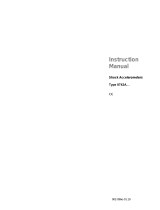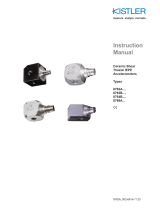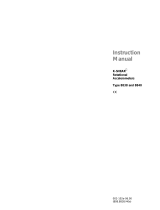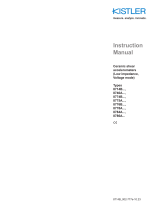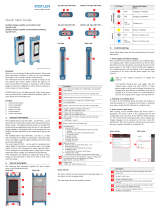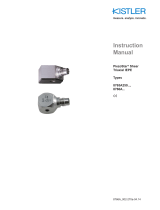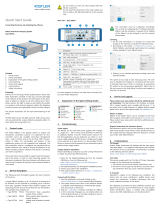
Instruction
Manual
Single-Axis K-Shear-
Accelerometers
Types
8702B...,
8704B...,
8728A...,
8730A...
ä
Single-Axis
PiezoStar
Accelerometers
Types
8703A...,
8705A...,
8712B...,
8715A/B...
ä
002-086e-11.21


Foreword
Foreword
002-086e-11.21
Thank you for choosing a Kistler quality product characterized
by technical innovation, precision and long life.
Information in this document is subject to change without notice.
Kistler reserves the right to change or improve its products and
make changes to the content without obligation to notify any
person or organization of such changes or improvements.
© 2006...2021 Kistler Group. All rights reserved. Except as ex-
pressly provided herein, no part of this manual may be repro-
duced for any purpose without the express prior written consent
of Kistler Group.
Kistler Group
Eulachstrasse 22
8408 Winterthur
Switzerland
Tel. +41 52 224 11 11
info@kistler.com
www.kistler.com
Page 1

002-086e-11.21Page 2
Single-Axis K-Shear and PiezoStar Accelerometers
Content
1. Introduction .......................................................................................................................................4
2. Important information ......................................................................................................................5
2.1 For your safety .......................................................................................................................5
2.2 Precautions ............................................................................................................................6
2.3 Disposal of electronic equipment ...........................................................................................6
2.4 Nomenclature .........................................................................................................................7
3. Product description ..........................................................................................................................8
3.1 Piezoelectric measurement concept ......................................................................................8
3.2 K-Shear background ..............................................................................................................9
3.3 PiezoStar background ..........................................................................................................10
3.4 Low impedance (IEPE) output..............................................................................................10
3.5 Accessories ..........................................................................................................................11
3.5.1 Studs .......................................................................................................................12
3.5.2 Adhesive mounting pads .........................................................................................13
3.5.3 Magnetic mounting bases .......................................................................................13
3.5.4 Triaxial mounting cubes ..........................................................................................14
3.5.5 Cables .....................................................................................................................15
4. Installation.......................................................................................................................................16
4.1 Surface preparation ..............................................................................................................16
4.2 Stud mounting ......................................................................................................................17
4.3 Direct adhesive mounting .....................................................................................................18
4.4 Mounting with wax ................................................................................................................19
4.5 Mounting with magnet ..........................................................................................................20
4.6 Summary of mounting methods ...........................................................................................21
4.7 Securing cables ....................................................................................................................22
4.8 Mass loading effects .............................................................................................................23
5. Operating instructions ...................................................................................................................24
5.1 Powering ..............................................................................................................................24
5.1.1 Using "Built-In" power sources................................................................................24
5.1.2 Kistler couplers .......................................................................................................25
5.1.3 The constant current power supply/coupler ............................................................25
5.1.4 Sensor power-up ....................................................................................................28
5.1.5 Overload recovery ..................................................................................................28
5.1.6 Supply voltage effects .............................................................................................29
5.1.7 Driving long cables .................................................................................................29

Page 3002-086e-11.21
Content
Total pages: 51
5.1.8 Ground loops ..........................................................................................................32
5.1.9 Ground isolation ......................................................................................................34
5.1.10 Frequency response limits ....................................................................................34
5.1.11 Frequency response denition and standards ......................................................34
5.1.12 High frequency limitations .....................................................................................35
5.1.13 Low Frequency limitations - accelerometer ..........................................................36
5.1.14 Low frequency limitations - coupler and read-out instrumentation .......................37
6. Technical data .................................................................................................................................39
7. Calibration & maintenance ............................................................................................................40
7.1 Calibration ............................................................................................................................40
7.2 Maintenance .........................................................................................................................40
8. Troubleshooting .............................................................................................................................41
9. Storage & transit considerations ..................................................................................................42
10. Warranty ........................................................................................................................................43
11. Declaration of conformity ............................................................................................................44

002-086e-11.21
Single-Axis K-Shear and PiezoStar Accelerometers
Page 4
Thank you for choosing a quality product from Kistler. Please
read through this manual thoroughly to enable you to fully
exploit the various features of your product.
To the extent permitted by law Kistler accepts no liability if
this instruction manual is not followed or products other than
those listed under Accessories are used. These instructions
describe Kistler Single-Axis K-Shear Quartz and PiezoStar
IEPE accelerometers.
Performance features at a glance:
High thermal stability with PiezoStar crystals for dynamic
temperature applications from –196 to 165 °C (–320 to
330 °F)
Wide frequency ranges thanks to high rigidity and reso-
nance frequencies
Long-term stability
Wide mounting congurations for all environments
Conforming to ä
Kistler offers a wide range of products for use in measuring
technology:
Piezoelectric sensors for measuring force, torque, strain,
pressure, acceleration, shock, vibration and acoustic
emission
Strain gage sensor systems for measuring force and
torque
Piezoresistive pressure sensors and transmitters
Signal conditioners, indicators and calibrators
Electronic control and monitoring systems, as well as
software for specic measurement applications
Data transmission modules (telemetry)
Kistler also develops and produces measuring solutions
for the application elds engines, vehicles, manufacturing,
plastics and biomechanics sectors.
Our product and application brochures, in addition to our
detailed data sheets, will provide you with an overview of our
product range.
If you require additional help beyond what can be located
online or in this manual, please contact Kistler‘s extensive
support organization or visit us online at www.kistler.com.
1. Introduction

002-086e-11.21
Important Information
Page 5
2. Important information
This product has been manufactured in compliance with
current valid safety regulations. It has left the factory in a
perfect, safe condition. In order to maintain this condition and
ensure safe operation, compliance is required with the inst-
ructions and warning notes contained within this manual or
imprinted on the product itself.
Compliance with local safety regulations, which may apply
to the use of power line operated electrical and electronic
equipment, is strongly recommended.
Do not drop the instrument.
Store in the case provided and in a clean, dry environ-
ment.
Power the instrument in accordance with the instructions
provided in this manual.
Do not mount accelerometers on high voltage surfaces.
Keep cable clear of power lines and open machinery.
It is essential for you to review the following information, which
is intended to ensure your personal safety when working with
the K-Shear and PiezoStar Shear IEPE Accelerometers and
contribute toward a long-fault-free service life.
2.1 For your safety

002-086e-11.21
Single-Axis K-Shear and PiezoStar Accelerometers
Page 6
2.3 Disposal of electronic equipment
2.2 Precautions
Compliance with the following precautionary measures is
vital to ensure safe and reliable operation:
▪ Never expose the instrument to contamination or oil mist.
▪ Never operate or store the instrument outside the specified
temperature range.
▪ Never exceed the maximum stated voltage
▪ DO NOT OVERTIGHTEN while stud or screw mounting the
sensor.
▪ Do not expose the unit to excessive shock, i.e. by using a
hammer or dropping the unit.
▪ When not in use, store the accelerometer in the container
supplied.
▪ The environment should be as dry, clean and free from
vibrations as possible.
▪ Keep the connector clean and covered when not in use.
▪ Follow the recommendations detailed in Section 7.2.
If there is evidence that safe operation is no longer possib-
le, the instrument must be powered off and rendered safe
against accidental start-up. Safe operation is no longer pos-
sible when the product:
▪ shows visible signs of damage
▪ is no longer operating
▪ has been subjected to prolonged storage under unsuitable
conditions
Do not discard old electronic equipment in municipal trash.
For disposal at end of life, please return this product to the
nearest authorized electronic waste disposal service or
contact your Kistler sales ofce for disposal instructions.

002-086e-11.21
Important Information
Page 7
Throughout this manual, special designations and
nomenclature are used for terms and concepts relating to
K-Shear and PiezoStar Shear sensors. These are identied
in Table 1.
Term Definition
Fs Full-scale
Es DC supply voltage (a/k/a compliance voltage)
Eb Bias voltage (from calibration certicate)
fFrequency in Hz
R1Output resistance of the coupler
R2Input resistance of the coupler
ICurrent in Amperes
CCapacitance in Farads
τTemperature
EOutput in Volts, Peak
R Read-out impedance
Z Input impedance
PiezoStar Special piezoelectric crystals
IEPE Integrated Electronics Piezoelectric
TEDS Transducer Electronic Data Sheet
Table 1: Manual nomenclature
2.4 Nomenclature

002-086e-11.21
Single-Axis K-Shear and PiezoStar Accelerometers
Page 8
3.1 Piezoelectric measurement concept
Piezoelectric accelerometers convert acceleration into an
electric charge. The charge derived by the accelerometer
is proportional to the force acting on the internal quartz
(piezoelectric) element. Accordingly, the mechanical variable
(acceleration) is derived from a force measurement.
3. Product description
Kistler K-Shear and PiezoStar accelerometers are shear
mode shock and vibration measuring instruments. A
self-generating piezoelectric sensing element is used
in conjunction with the built-in, internal circuit Piezotron
impedance converter. As with most accelerometers, the
sensitivity of this series is expressed in terms of the ratio of
the electrical output to applied acceleration (e.g. mV/g). In
the case of Piezotron devices, such as K-Shear, the output
is a low impedance voltage signal that is proportional to the
applied acceleration. K-Shear accelerometers utilize a quartz
piezoelectric crystal, while PiezoStar accelerometers utilize
a proprietary piezoelectric crystal to create the acceleration
charge.
Being a low impedance device, no charge amplier or
special cabling is required and transmission over long lines is
possible with a minimum of noise pick-up.
Accelerometers with a “T” sufx, such as Type 8702B…T
are variants of the standard version incorporating the 'Smart
Sensor' design. Viewing an accelerometer’s data sheet
requires a compatible Data Acquisition system or coupler,
such as Kistler LabAmp Type 5165A... The Interface provides
negative current excitation (reverse polarity), thereby altering
the operating mode of the PiezoSmart sensor and allowing
the program editor software to read or add information
contained in the memory chip.
Kistler publication K20.302 IEEE P 1451.4 Measurement
with Smart Transducers includes information on the IEEE
Standard 1451.4, the operating manner of smart sensors,
and a detailed review of the TEDS Editor and data sheet
content. Call Kistler to request a copy.

002-086e-11.21
Product Description
Page 9
3.2 K-Shear background
The sensing assembly (see Fig. 1) consists of a center post,
quartz piezoelectric crystals, seismic mass and a preload
bolt. Since the unit is operated in a shear arrangement,
it will sense motion perpendicular to the base. When the
accelerometer is attached to a vibrating structure, the mass
exerts a shear force on the quartz piezoelectric crystal. This
applied force causes the piezoelectric material to produce
an electric charge. Force = mass x’s acceleration (from
Newton's second law). Since m is the constant, the charge
produced is proportional to acceleration. This is represented
by the equation:
a = F
—
m
Fig. 1: Inside view of a typical single-axis shear accelerom-
eter
The K-Shear sensing element offers many advantages
over previous shear and compression mode designs. Due
to its shear construction, the accelerometer is insensitive to
thermal transients, transverse (cross-axis) motion and the
effects of base strain. This insensitivity to activities occurring
in an adjacent axis minimize cross talk effects in these triaxial
accelerometers.

002-086e-11.21
Single-Axis K-Shear and PiezoStar Accelerometers
Page 10
3.3 PiezoStar background
Kistler PiezoStar accelerometers utilize the same basic con-
struction as our K-Shear accelerometers except for one key
difference. PiezoStar accelerometers utilize a new proprie-
tary piezoelectric crystal which produces higher charge out-
put when compared to quartz based accelerometers and also
a have a higher operating temperature. When mated with in-
ternal Piezotron electronics, the accelerometer has the addi-
tional benefit of providing much lower temperature coefficient
of sensitivity when compared to quartz and ceramic-based
accelerometers.
3.4 Low impedance (IEPE) output
Contained within the accelerometer housing is a miniature
electronic circuit. This circuit converts the high impedance
charge signal generated by the piezoelectric element into a
low impedance voltage output signal. All accelerometer types
have a nominal output less than 100 ohms.
The integral impedance converter is powered by an external
power source (coupler) that uses a two-wire cable between
the accelerometer and coupler. The signal and power source
share a common line. The coupler provides a constant
current source to the accelerometer and decouples the DC
bias (see Section 5.1.3) from the measuring instrument. The
useable signal is seen as a varying voltage over an 11 VDC
(nominal) bias.
Low impedance accelerometers are ideally suited for
applications where long or moving cables are required, in
high humidity or other impure atmospheres. They eliminate
the difculties associated with a high impedance output
by providing a voltage signal with low impedance and a
high frequency response. The calibration factors for these
accelerometers are given in mV/g.
Table 2 depicts a typical low impedance measurement
system. Couplers vary considerably in appearance,
depending upon the application and the number of sensors
making up the system. It can also be directly integrated to the
data acquisition system.

002-086e-11.21
Product Description
Note: Due to its miniaturize connector, the Type 8715A/B... sensor will need an extension cable Type 1766A between the sensor and
the Type 1761B cable.
IEPE sensor and customer IEPE compatible DAQ
IEPE sensor and Kistler LabAmp
Page 11
Table 2: IEPE sensor/customer IEPE compatible DAQ and
IEPE sensor and Kistler LabAmp measuring chains
Measuring Connecting Amplifying Acquiring Analyzing
Type 87... Type 1761B... IEPE Compatible Data Acquisition
Unit (customer supplied)
Laptop (customer supplied)
Measuring Connecting Amplifying Acquiring Analyzing
Type 87... Ethernet Cable Notebook with LabAmp GUI
Type 5165A...
Conditioning and Data Acquisition
Analog Output ±10 V
Type 1511
Type 1761B...
3.5 Accessories
All accelerometers designed for stud mounting are supplied
with the appropriate studs. All accelerometers designed for
screw assembly mounting are supplied with a mounting
screw. All units intended for adhesive mounting are provided
with mounting wax. See Tables 3, 4 & 5 for more details re-
garding mounting stud dimensions or refer to the unit speci-
fications listed on the respective data sheet for each model.
5050B
8202A
8702B
5165A
Data Accquisition Unit
8763 B
8395A
8315A
5146A15
5134B
1631C
1761B
1592A
1792A
Ethernet Kabel
1756C
1635C
1511

002-086e-11.21
Single-Axis K-Shear and PiezoStar Accelerometers
X
CA
D
Y
Page 12
3.5.1 Studs
Type A B C D E Used with
8402 2.5
[0.10]
2.5
[0.10]
7.1
[0.28]
10-32
UNF
10-32
UNF 8702, 8704
8410 2.0
[0.08]
3.2
[0.13]
6.4
[0.25] 10-32 ¼–28 8712
8411 2.8
[0.11]
6.6
[0.26]
10.4
[0.41]
10-32
UNF M6 8702, 8704
8412 ––9.5
[0.37] – ¼–28 8712
8421 3.3
[0.13]
7.5
[0.30]
12.3
[0.48] ¼–28 M8 8712
8451 2.8
[0.11]
5.0
[0.20]
8.8
[0.34] 10-32 M5 8702, 8703,
8704, 8705
8453 3.7
[0.15]
5.1
[0.20]
9.8
[0.38] M5 ¼–28 8712
Table 3: Mounting studs (dimensions in mm [in])
The following studs can be used with Kistler accelerometers:
Isolated mounting studs are also available to avoid ground
loop issues.
Type A C D THD.
X
THD.
YUsed with
8400K01 3.4
[0.13]
11.6
[0.46]
12.7 Hex
[0.50 Hex] 10-32 10-32 8702, 8703,
8704, 8705
8400K03 5.5
[0.22]
12.8
[0.50]
19.1 Hex
[0.75 Hex] 10-32 M6 8702, 8703,
8704, 8705
Table 4: Isolated mounting studs (dimensions in mm [in])

002-086e-11.21
Product Description
X
CA
DY
Page 13
3.5.2 Adhesive mounting pads
Keeps adhesive material out of the tapped hole or stud and
provides ground isolation.
Type Description
8434,
8436M02 Use to adhesively mount Type 8730
8436 Use to adhesively mount Types 8702, 8703, 8704, 8705
8438 Use to adhesively mount Types 8712
Type A C D THD.
X
THD.
YUsed with
8466K07 5.1
[0.20]
7.6
[0.30]
8.89 Hex
[0.35 Hex] 5-40 5-40 8730
3.5.3 Magnetic mounting bases
These offer a convenient, temporary attachment to a
ferromag netic test structure. A notched mounting unit is avail-
able for mounting on curved surfaces. Magnetic bases nd
use in appli cations requiring vibration monitoring of large ro-
tating machin ery. Note that usage of some mounting bases
can add consider able mass and reduce high frequency re-
sponse. High care should be taken while usage of magnetic
mounting bases in order to avoid shock during ferromagnetic
surface approach. This could lead to irreversible damage to
the sensor.
Type Description
8440K03 Mounting base with integral stud for adhesive mounting;
Types 8702, 8703, 8704, 8705
Table 5: Isolated mounting adaptor (dimensions in mm [in])
Table 6: Adhesive mounting bases with female thread
Table 7: Adhesive mounting bases with male thread

002-086e-11.21
Single-Axis K-Shear and PiezoStar Accelerometers
X
B
A
Page 14
3.5.4 Triaxial mounting cubes
Allows for two or three single-axis accelerometers to be pre-
cisely mounted to perform biaxial or triaxial acceleration mea-
surements. Cube attachment to the test surface can either be
by stud or adhesive for some types. Accelerometer attach-
ment to the cube can be in a similar manner.
Type Description
8502 For use with Types 8702, 8703, 8704, and 8705.
Weight: 117 grams
8510 For use with Type 8730.
Weight: 19 grams
8514 For use with Types 8702 and 8704.
Weight: 35 grams
Type A B C THD.
XUsed with
8450A 7.6
[0.30]
12.7
[0.50]
11.1
[0.44]
5-40
fem. 8730
8452A 11.2
[0.44]
17.8
[0.70]
15.9
[0.62]
10-32
fem.
8702, 8703, 8704,
8705
8456 11.3
[0.44]
25.0
[0.98] –¼–28
male 8712
KIG4662
B-3
14.0
[0.55]
18.0
[0.71] –10-32
male 8702, 8705
KIG4662
B-4
10.9
[0.43]
18.0
[0.71]
12.7
[0.50]
6-32
fem.
8702, 8703, 8704,
8705
KIG4662
B-6
5.8
[0.23]
9.4
[0.37]
7.1
[0.28]
5-40
fem. 8730
Table 8: Magnetic mounting adaptors (dimensions in mm
[in])
Table 9: Triaxial mounting cubes

002-086e-11.21
Product Description
Page 15
3.5.5 Cables
All K-Shear and Piezostar accelerometers with detachable
cables are furnished without cables. Refer to cable datasheet
Ref. 000-471 for more details.
Cables used with K-Shear and Piezostar accelerometers are
summarized below.
Type Description
1761B... General purpose cable/connector. 10-32 pos. to BNC pos.
Accelerometer output cable.
1762B... General purpose cable/connector. 10-32 pos. to 10-32
pos. Accelerometer output cable.
1511sp General purpose cable/connector. BNC pos to BNC pos.
Output or extension cable.
1766AK01 Extension cable 5-44 pos. to 10-32 neg. for usage with
Type 8715A/B... sensors
1768A...K01 Flexible cable 10-32 pos. to BNC pos. Accelerometer
output cable
1768A...K02 Flexible cable 10-32 pos. to 10-32 pos. Accelerometer
output cable
Table 10: Cables

002-086e-11.21
Single-Axis K-Shear and PiezoStar Accelerometers
Page 16
4. Installation
This section provides the user with a quick means of placing
the Kistler K-Shear or PiezoStar Shear IEPE accelerometers
into operation. Careful installation will result in optimal, high
frequency response, accuracy and reliability. Dimensional
characteristics can be found on their respective data sheets.
Table 11: Mounting options
4.1 Surface preparation
A clean, at surface is necessary for both stud and adhesive-
mounted accelerometers. If the surface is not completely at,
the coupling between the accelerometer and the test article
introduces distortion into the measurement. A rough surface
creates voids between the mounting surfaces that reduce
high frequency transmissibility.
Type Mounting description
8702B... Stud, magnet or adhesive mounting
8703A... Stud, magnet or adhesive mounting
8704B... Stud, magnet or adhesive mounting
8705A... Stud, magnet or adhesive mounting
8712B... Stud, magnet or adhesive mounting
8715A/B... Adhesive, through hole screw mounting
8728A... Adhesive mounting
8730A... Stud, magnet or adhesive mounting (with base)

002-086e-11.21
Installation
Page 17
4.2 Stud mounting
Type 8730A… is specically designed for stud mounting.
Most Kistler mounting studs are machined from Beryllium
Copper for high strength and low modulus of elasticity,
coupled with high elastic limits. The studs are removable,
allowing both stud and adhesive mounting. The studs on
Types 8702B…, 8703A…,8704B…, 8705A…, and 8712A…
are removable allowing both stud and adhesive mounting The
Type 8715A/B... sensor is delivered with a ground isolated
screw kit for through hole mounting. The following guidelines
should be followed when stud mounting accelerometers:
1. Drill and tap an adequate hole to ensure a ush mount of
the accelerometer. Make sure the stud does not bottom
out and rmly secures the accelerometer. A chamfer
should be machined at the top of the mounting hole to
ensure that the base of the accelerometer.
2. Completely clean the surface prior to mounting.
3. Apply a thin coat of silicon grease to both the acclerometer
and the mounting surface.
4. Always use the proper sockets and a torque wrench when
installing accelerometers. Tighten the accelerometer
to the torque specied on the individually supplied
calibration certicate or as specied in Table 12. DO NOT
OVERTIGHTEN.
N·min-lbs Accelerometer Types
2±0.2 18±28702, 8703, 8704, 8705, 8712
1±0.1 10±28730
0.5±0.05 4.5±0.5 8715
Table 12: Recommended mounting torque
For optimal frequency response with stud mount units, the
surface and hole preparation should be performed according
to the instructions in Table 13. The roughness should not
exceed 32 micro inches (0.8 micrometers).

002-086e-11.21
Single-Axis K-Shear and PiezoStar Accelerometers
Page 18
Stud Type D L1 mm [in] L2 mm [in]
8400K01 10-32 6.0 [0.24] 9.4 [0.37]
8400K03 M6 4.5 [0.18] 8.0 [0.32]
8402 10-32 4.0 [0.16] 8.0 [0.32]
8410 10-32 4.0 [0.16] 8.0 [0.32]
8411 M6 8.0 [0.32] 12.0 [0.47]
8412 ¼–28 5.0 [0.20] 11.0 [0.43]
8421 M8 8.0 [0.31] 16.0 [0.63]
8446AE3 M2.5 6.0 [0.24] 10.0 [0.39]
8446AM3 4-40 5.0 [0.20] 8.0 [0.32]
8453 M5 6.4 [0.25] 9.6 [0.37]
Table 13: Stud mounting preparation
4.3 Direct adhesive mounting
Some K-Shear accelerometers are specically designed
for adhesive mounting (i.e. Type 8728A500 and eventually
Type 8715A/B...) and require no special mounting adapters.
Units furnished with stud holes or screws can also be used
with adhesives.
The surface should be smooth and at. A cyanoacrylate
type adhesive, such as Eastman 910 or Loctite 496 super
glue, is recommended. While epoxies can also be used,
cyanoacrylate adhesives provide an extremely thin bond
which provides optimal frequency response.
Page is loading ...
Page is loading ...
Page is loading ...
Page is loading ...
Page is loading ...
Page is loading ...
Page is loading ...
Page is loading ...
Page is loading ...
Page is loading ...
Page is loading ...
Page is loading ...
Page is loading ...
Page is loading ...
Page is loading ...
Page is loading ...
Page is loading ...
Page is loading ...
Page is loading ...
Page is loading ...
Page is loading ...
Page is loading ...
Page is loading ...
Page is loading ...
Page is loading ...
Page is loading ...
Page is loading ...
Page is loading ...
Page is loading ...
Page is loading ...
Page is loading ...
Page is loading ...
Page is loading ...
/

